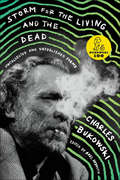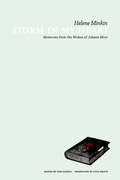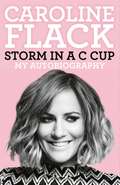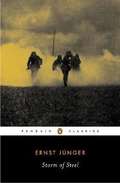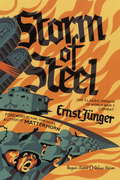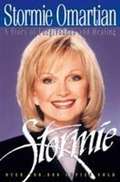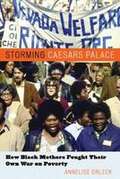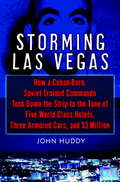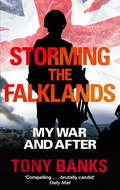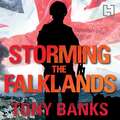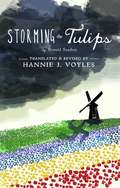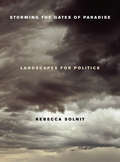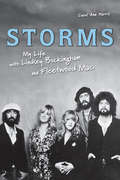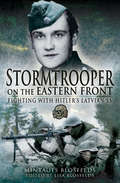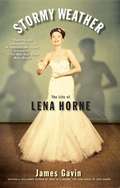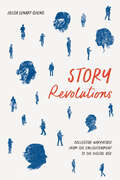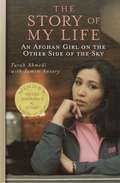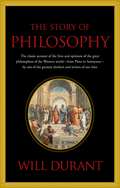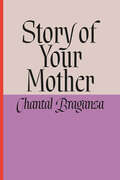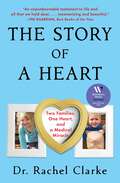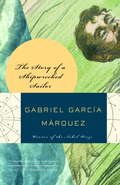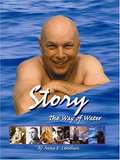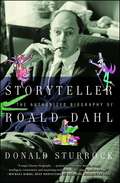- Table View
- List View
Storm for the Living and the Dead: Uncollected and Unpublished Poems
by Charles BukowskiA timeless selection of some of Charles Bukowski’s best unpublished and uncollected poemsCharles Bukowski was a prolific writer who produced countless short stories, novels, and poems that have reached beyond their time and place to speak to generations of readers all over the world. Many of his poems remain little known, material that appeared in small magazines but was never collected, and a large number of them have yet to be published. In Storm for the Living and the Dead, Abel Debritto has curated the very finest of this material—poems from obscure, hard-to-find magazines, as well as from libraries and private collections all over the country—most of which will be new to Bukowski’s readers and some of which has never been seen before. In doing so, Debritto has captured the essence of Bukowski’s inimitable poetic style—tough and hilarious but ringing with humanity. Storm for the Living and the Dead is a gift for any devotee of the Dirty Old Man of American letters.
Storm in My Heart
by Helene MinkinPartner of one of the most infamous anarchists of her time, Johann Most, Helene Minkin joined the anarchist movement after emigrating from Russia in 1888 with her father and sister. Framed as a reaction and corrective to Emma Goldman's Living My Life, Minkin's memoir provides a unique account of turn-of-the-century anarchism and immigrant life in the United States. Published in the Yiddish-language newspaper Forverts in 1932, this is its first English translation. Tom Goyens teaches American history at Salisbury University in Maryland. He is the author of Beer and Revolution: The German Anarchist Movement in New York City, 1880–1914.
Storm in a C Cup: My Autobiography
by Caroline FlackThe frank and insightful memoir from much-missed television star Caroline Flack. Known for her throaty laugh, edgy humour and quick-fire wit, showcased on some of Britain&’s most popular shows, Caroline Flack was the star of reality TV shows from The X Factor to Love Island, as well as a winner on Strictly. In Storm in a C Cup, Caroline reveals the laughter and pain behind the TV persona, from a sheltered Norfolk childhood shared with her twin sister, through her madcap student days, to the challenging career ladder, leading to eventual TV success – and its dark shadow, when intrusive media attention turned the dream into a nightmare. Caroline wears her heart on her sleeve, documenting her joys and heartbreaks with the humour, resilience and unflinching emotional honesty that made her one of television&’s most popular celebrities.
Storm of Steel
by Michael Hofmann Ernst JungerThe memoir widely viewed as the best account ever written of fighting in WW1<P> A memoir of astonishing power, savagery, and ashen lyricism, Storm of Steel illuminates not only the horrors but also the fascination of total war, seen through the eyes of an ordinary German soldier. Young, tough, patriotic, but also disturbingly self-aware, Jünger exulted in the Great War, which he saw not just as a great national conflict but—more importantly—as a unique personal struggle. Leading raiding parties, defending trenches against murderous British incursions, simply enduring as shells tore his comrades apart, Jünger kept testing himself, braced for the death that will mark his failure. Published shortly after the war’s end, Storm of Steel was a worldwide bestseller and can now be rediscovered through Michael Hofmann’s brilliant new translation.
Storm of Steel: (Penguin Classics Deluxe Edition) (Penguin Classics)
by Michael Hofmann Karl Marlantes Ernst Junger Neil GowerThe memoir widely viewed as the best account ever written of fighting in WW1A memoir of astonishing power, savagery, and ashen lyricism, Storm of Steel illuminates not only the horrors but also the fascination of total war, seen through the eyes of an ordinary German soldier. Young, tough, patriotic, but also disturbingly self-aware, Jünger exulted in the Great War, which he saw not just as a great national conflict but--more importantly--as a unique personal struggle. Leading raiding parties, defending trenches against murderous British incursions, simply enduring as shells tore his comrades apart, Jünger kept testing himself, braced for the death that will mark his failure. Published shortly after the war's end, Storm of Steel was a worldwide bestseller and can now be rediscovered through Michael Hofmann's brilliant new translation.For more than sixty-five years, Penguin has been the leading publisher of classic literature in the English-speaking world. With more than 1,500 titles, Penguin Classics represents a global bookshelf of the best works throughout history and across genres and disciplines. Readers trust the series to provide authoritative texts enhanced by introductions and notes by distinguished scholars and contemporary authors, as well as up-to-date translations by award-winning translators.
Stormie: A Story of Forgiveness and Healing
by Stormie Omartian"I have a burning desire to tell people who are hurting that there is a way out of their pain. . . There is hope for their lives." Stormie Omartian tells her compelling story of a childhood marred by physical and emotional abuse that eventually led her into the occult, drugs, and tragic relationships. Finding herself overwhelmed by fear and on the verse of suicide, she shares with us the turning point that changed her life and reveals the healing process that brought freedom and wholeness beyond what she ever imagined. In this poignant drama, there is help and hope for anyone who has been scarred by the past or feels imprisoned by deep emotional needs. It is a glorious story of how God can bring life out of death.
Storming Caesars Palace: How Black Mothers Fought Their Own War on Poverty
by Annelise OrleckIn Storming Caesars Palace, historian Annelise Orleck tells the compelling story of how a group of welfare mothers built one of this country's most successful antipoverty programs. Declaring "We can do it and do it better," these women proved that poor mothers are the real experts on poverty. In 1972 they founded Operation Life, which was responsible for many firsts for the poor in Las Vegas-the first library, medical center, daycare center, job training, and senior citizen housing. By the late 1970s, Operation Life was bringing millions of dollars into the community. These women became influential in Washington, DC-respected and listened to by political heavyweights such as Daniel Patrick Moynihan, Ted Kennedy, and Jimmy Carter. Though they lost their funding with the country's move toward conservatism in the 1980s, their struggles and phenomenal triumphs still stand as a critical lesson about what can be achieved when those on welfare chart their own course.
Storming Las Vegas: How a Cuban-Born, Soviet-Trained Commando Took Down the Strip to the Tune of Five World-Class Hotels, Three Armored Cars, and $3 Million
by John Huddy“In my world, you are either the hunter or the prey, and I am the hunter. Vegas was my prey. I tell my crew: Vegas makes it, Vigoa takes it.”–Jose Vigoa[pg. 37]When it comes to violent crime, the Las Vegas cops and casino owners thought they had seen it all. But they had never witnessed anything like Jose Vigoa.Born in Cuba, a child of Fidel Castro’s revolution, Vigoa used his quick wits and quicker fists to trade a life of poverty and desperation for one of danger and adventure as a Soviet-trained special forces officer. Battle hardened in the killing fields of Afghanistan and Angola, Vigoa won a reputation for toughness, bravery, and coolness under fire. A brilliant military career lay ahead of him.Then, in 1980, Castro opened Cuba’s floodgates in the Mariel boatlift, and Vigoa, like so many of his countrymen and -women, braved chaos and hardship to start a new life in America’s promised land. But involvement with the drug trade brought his dreams crashing down. Years of prison followed.On his release, Vigoa was determined to take revenge on what he perceived as the corrupt power structure of Las Vegas. On September 20, 1998, the former Spetsnaz lieutenant launched what would be the most audacious and ruthless series of high-profile casino and armored car robberies that Las Vegas had ever seen. In a brazen sixteen-month-long reign of terror, he and his tightly disciplined crew would hit the crème de la crème of Vegas hotels: the MGM, the Desert Inn, the New York-New York, the Mandalay Bay, and the Bellagio. They struck hard and fast, then vanished without a trace. Millions of dollars were stolen. Two brave men were gunned down in cold blood; others were wounded. And yet the robberies were so well planned and executed that the police–“the stupids,” as Vigoa contemptuously referred to them–were all but helpless.Not Lt. John Alamshaw. The twenty-three-year veteran, in charge of robbery detectives, was not giving up so easily. For him, Vigoa’s rampage was a personal affront. And he would do whatever it took, even risk his badge, to bring Vigao down.With exclusive access to all the major players, including Vigoa and Alamshaw, veteran journalist and network producer John Huddy is the perfect man to tell the gripping never-before-told story of this harrowing true-crime drama that will leave readers breathless.From the Hardcover edition.
Storming The Falklands: My War and After
by Tony BanksThirty years after the Falklands War 'Secret Millionaire' Tony Banks is still haunted by his experiences in the South Atlantic. As a member of the crack Parachute Regiment his unit was the first to land on the Falklands and he fought in the bloody first and last battles of the war before liberating Port Stanley.In this memoir Tony vividly recalls the fighting in the Falklands. He relives the bombing raids in San Carlos bay, the Battle of Goose Green, the Argentinian attack on the Sir Galahad and the Battle of Wireless Ridge. But he also tells of his own battles with Combat Stress and of how three decades on the war is still claiming victims.He tells the stories of British and Argentine veterans and travels to Argentina to return a war trophy - a trumpet he had taken from a prisoner - to its rightful owner. The return of the trumpet brings closure to both men. And finally Tony returns to the Falklands to lay the ghosts that have haunted him to rest.
Storming The Falklands: My War and After
by Tony BanksThirty years after the Falklands War 'Secret Millionaire' Tony Banks is still haunted by his experiences in the South Atlantic. As a member of the crack Parachute Regiment his unit was the first to land on the Falklands and he fought in the bloody first and last battles of the war before liberating Port Stanley.In this memoir Tony vividly recalls the fighting in the Falklands. He relives the bombing raids in San Carlos bay, the Battle of Goose Green, the Argentinian attack on the Sir Galahad and the Battle of Wireless Ridge. But he also tells of his own battles with Combat Stress and of how three decades on the war is still claiming victims.He tells the stories of British and Argentine veterans and travels to Argentina to return a war trophy - a trumpet he had taken from a prisoner - to its rightful owner. The return of the trumpet brings closure to both men. And finally Tony returns to the Falklands to lay the ghosts that have haunted him to rest.
Storming The Falklands: My War and After (William Lorimer)
by Tony BanksThirty years after the Falklands War 'Secret Millionaire' Tony Banks is still haunted by his experiences in the South Atlantic. As a member of the crack Parachute Regiment his unit was the first to land on the Falklands and he fought in the bloody first and last battles of the war before liberating Port Stanley.In this memoir Tony vividly recalls the fighting in the Falklands. He relives the bombing raids in San Carlos bay, the Battle of Goose Green, the Argentinian attack on the Sir Galahad and the Battle of Wireless Ridge. But he also tells of his own battles with Combat Stress and of how three decades on the war is still claiming victims.He tells the stories of British and Argentine veterans and travels to Argentina to return a war trophy - a trumpet he had taken from a prisoner - to its rightful owner. The return of the trumpet brings closure to both men. And finally Tony returns to the Falklands to lay the ghosts that have haunted him to rest.
Storming The Tulips: A Companion To The Diary Of Anne Frank
by Translated By Ronald Sanders Nancy L. Baumann (Editor Editor-In-Chief Hannie J. Voyles (EditedThis is companion to Anne Frank's Diary of a Young Girl is loved by students and teachers as they learn to understand the world beyond the Annex. Not just another Holocaust story, Storming the Tulips is an intimate encounter with history, as told by twenty former students of the 1st Montessori School in Amsterdam. They were children-contemporaries of Anne Frank-and this book is a companion her Diary of a Young Girl. While Anne's story describes her sequestered life in the Annex, Storming the Tulips reveals what children on the outside experienced-in the streets, in hiding, and in the concentration camps. It is a staple in Holocaust education curricula in all parts of the world.
Storming the Gates of Paradise: Landscapes for Politics
by Rebecca SolnitRebecca Solnit has made a vocation of journeying into difficult territory and reporting back, as an environmentalist, anti-globalization activist, and public intellectual. Storming the Gates of Paradise, an anthology of her essential essays from the past ten years, takes the reader from the Pyrenees to the U.S.--Mexican border, from San Francisco to London, from open sky to the deepest mines, and from the antislavery struggles of two hundred years ago to today's street protests. The nearly forty essays collected here comprise a unique guidebook to the American landscape after the millennium--not just the deserts, skies, gardens, and wilderness areas that have long made up Solnit's subject matter, but the social landscape of democracy and repression, of borders, ruins, and protests. She ventures into territories as dark as prison and as sublime as a broad vista, revealing beauty in the harshest landscape and political struggle in the most apparently serene view. Her introduction sets the tone and the book's overarching themes as she describes Thoreau, leaving the jail cell where he had been confined for refusing to pay war taxes and proceeding directly to his favorite huckleberry patch. In this way she links pleasure to politics, brilliantly demonstrating that the path to paradise has often run through prison. These startling insights on current affairs, politics, culture, and history, always expressed in Solnit's pellucid and graceful prose, constantly revise our views of the otherwise ordinary and familiar. Illustrated throughout, Storming the Gates of Paradise represents recent developments in Solnit's thinking and offers the reader a panoramic world view enriched by her characteristically provocative, inspiring, and hopeful observations.
Storms: My Life with Lindsey Buckingham and Fleetwood Mac
by Carol Ann HarrisA consummate insider as the girlfriend of Lindsey Buckingham, Fleetwood Mac singer and guitarist, Carol Ann Harris leads fans into the very heart of the band's storms between 1976 and 1984. From interactions between the band and other stars--Mick Jagger, Eric Clapton, and Dennis Wilson--to the chaotic animosity between band members, this memoir combines the sensational account of some of the world's most famous musicians with a thrilling love story. The parties, fights, drug use, shenanigans, and sex lives of Fleetwood Mac are presented in intimate detail and illustrated with never-before-seen photographs. With the exception of one brief interview, Carol Ann Harris has never before spoken about her time with Fleetwood Mac.
Stormtrooper on the Eastern Front: Fighting with Hitler's Latvian SS
by Mintauts BlosfeldsThe memoir of a reluctant soldier coerced into military service by the Nazis and driven from his homeland by the Russians. Following the conquest of his native Latvia by the Nazis, Mintauts Blosfelds was given the stark choice: service in the SS or forced labor in a slave camp. So he &“volunteered&” to fight for the Nazis. In this memoir he describes his training and how he became an instructor before being sent into Russia. He nearly perished during the terrible winter of 1943–44 after being wounded and finding himself with his friend lying dead on top of him. As the tide turned, the Russians advanced remorselessly through. He would be wounded twice more and awarded the Iron Cross for bravery. With German resistance collapsing, he had to flee for his life—capture by the Russians meant almost certain death. He surrendered to the Americans, but describes the neglect he suffered at their hands. Unable to return to Latvia, which was now occupied by the Russians, he became a Displaced Person, eventually settling in the UK. This book tells his compelling story.
Stormy Weather
by James GavinTHE "DEFINITIVE" (VANITY FAIR ) BIOGRAPHY OF LEGEND LENA HORNE--THE CELEBRATED STAR OF STAGE, MUSIC, AND FILM WHO BLAZED A TRAIL FOR AFRICAN AMERICANS IN HOLLYWOOD AND BEYONDDrawing on a wealth of unmined material and hundreds of interviews-- one of them with Lena Horne herself--critically acclaimed author James Gavin gives us a "deftly researched" (The Boston Globe) and authoritative portrait of the American icon. Horne broke down racial barriers in the entertainment industry in the 1940s and '50s even as she was limited mostly to guest singing appearances in splashy Hollywood musicals. Incorporating insights from the likes of Ruby Dee, Tony Bennett, Diahann Carroll, and Bobby Short, Stormy Weather reveals the many faces of this luminous, complex, strong-willed, passionate, even tragic woman--a stunning talent who inspired such giants as Barbra Streisand, Eartha Kitt, and Aretha Franklin.Cotton Club, Stormy Weather offers a fascinating portrait of a complex, even tragic Horne -- a stunning talent who inspired such giants of showbiz as Barbra Streisand, Eartha Kitt, and Aretha Franklin, but whose frustrations with racism, and with tumultuous, root-less childhood, left wounds too deep to heal. The woman who emerged was as angry as she was luminous. From the Cotton Club's glory days and the back lots of Hollywood's biggest studios to the glitzy but bigoted hotels of Las Vegas's heyday, this behind-the-scenes look at an American icon is as much a story of the limits of the American dream as it is a masterful, ground-breaking biography.
Story Revolutions: Collective Narratives from the Enlightenment to the Digital Age (Cultural Frames, Framing Culture)
by Helga Lenart-ChengSocial media has facilitated the sharing of once isolated testimonies to an extent and with an ease never before possible. The #MeToo movement provides a prime example of how such pooling of individual stories, in large enough numbers, can fuel political movements, fortify a sense of solidarity and community, and compel public reckoning by bringing important issues into mainstream consciousness.In this timely and important study, Helga Lenart-Cheng has uncovered the antecedents of this phenomenon and provided a historical and critical analysis of this seemingly new but in fact deeply rooted tradition. Story Revolutions features a rich variety of case studies, from eighteenth-century memoir collections to contemporary Web 2.0 databases, including memoir contests, digital story-maps, crowd-sourced Covid diaries, and AI-assisted life writing. It spans the Enlightenment, the 1930s, and the twenty-first century—three historical periods marked by a convergence of mass movements and new methods of data collection that led to a boom in activism based in the aggregation and communication of stories. Ultimately, this book offers readers a critical perspective on the concept of community itself, with incisive reflections on what it means to use storytelling to build democracy in the twenty-first century.
Story of My Life: An Afghan Girl on the Other Side of the Sky
by Tamim Ansary Farah Ahmedi"I was late to school, and that's all I could think about. I started across the field. And then suddenly a fire flashed in my face and the earth seemed to move beneath my feet. I remember a shower of soil and then nothing. I woke up on the ground, surrounded by a crowd, men and boys...no women. They were all staring down at me with huge eyes. Their lips were moving, but I could hear no voices. All I heard was a loud ringing in my ears." <P><P> Farah Ahmedi is born into the world just as the war between the mujahideen and the Soviets reaches its peak in Afghanistan. Bombs are falling all over her country, and her native Kabul is swelling with hundreds of thousands of people looking for homes and jobs. The sounds of gunfire and fighter planes are as normal to Farah as the sounds of traffic or children playing are to a schoolgirl in America. When Farah steps on a land mine on her way to school, her world becomes much smaller than the dreams and hopes in her heart. She begins to learn--slowly--that ordinary people, often strangers, have immense power to save lives and restore hope. <P> The Story of My Life: An Afghan Girl on the Other Side of the Sky recounts an epic journey. It deftly interweaves a childhood in Afghanistan, where the classrooms are naked chambers with only chalkboards on the walls and are filled with more students than seats (and no books), with an American adolescence, where teenagers struggle to decide whether to try out for school plays, whom to take to the homecoming dance, and where to go to college. In Kabul, they cancel school because of rockets and bombings; in Chicago, Farah might have a snow day. In Kabul, a schoolgirl wears a black dress and a white headscarf; in America, girls need the right jeans and trendy tops. <P> Thanks to a number of good people who crossed her path at critical moments, Farah is thriving. She may be haunted by her past, but she is no longer enslaved by it. She is actively enjoying the realization of her childhood dreams; she's an Afghan American, free to learn, work, support herself, and choose her own path. She'll graduate from high school soon and is being recruited by some of the best colleges in the world. Farah is living proof that not only can the human heart endure, it can also thrive. Even in war, there are miracles. Even when limbs are amputated, we are whole. Even in refugee camps, dreams come true. Even when fathers and siblings die young, there is love. The Story of My Life is our new great American memoir.
Story of Philosophy: The Lives And Opinions Of The Great Philosophers
by Will DurantA brilliant and concise account of the lives and ideas of the great philosophers -- Plato, Aristotle, Bacon, Spinoza, Voltaire, Kant, Schopenhauer, Spencer, Nietzsche, Bergson, Croce, Russell, Santayana, James and Dewey -- The Story of Philosophy is one of the great books of our time. Few write for the nonspecialist as well as Will Durant, and this book is a splendid example of his eminently readable scholarship. Durant's insight and wit never cease to dazzle; The Story of Philosophy is a key book for any reader who wishes to survey the history and development of philosophical ideas in the Western world.yle. The Story of Philosophy opens vistas of intellectual adventure and growth to those who hunger for the total perspective that is philosophy. Within its pages, Durant seeks the wisest and most indestructible answers from the world's greatest philosophers to the persistent and fundamental questions about first and last things.
Story of Your Mother
by Chantal BraganzaWhat if we considered motherhood an organizing principle instead of a genre or subject?In her debut book of essays, Chantal Braganza considers the limits of understanding motherhood as identity or action alone, while reflecting on her upbringing as a daughter of Mexican and Indian immigrants and the first years of raising her two children. Inspired by the thinking of Dionne Brand, Maggie Nelson and Jacqueline Rose, she explores what shapes the things we reach for as we search for our family's place in the world. How do we tell our children who they are when we're still struggling to find that language to describe ourselves?Braganza weaves dreamlike memoir sections of her childhood—some memories, some myths passed down from her family in Vallarta, Mombasa, London, and Toronto—with urgent essays about migration, identity, and speech. She wrangles with the limits of language—finding that even fluency doesn't guarantee the ability to translate something for your children. She engages with the physicality of motherhood and loss, nourishment and violence. The questions that emerge are: Can we believe the people who have given us the story of who we are? And how do we craft that story for our own children?
Story of a Heart: Two Families, One Heart, and the Medical Miracle that Saved a Child's Life
by Rachel ClarkeA riveting and inspiring true story of two families linked by one heart—written by a bestselling author and palliative care doctor. The first of our organs to form and the last to die, the heart is both a simple pump and the symbol of what makes us human; as long as it continues to beat, there is hope. In The Story of a Heart, Dr. Rachel Clarke interweaves the history of medical innovations behind transplant surgery with the story of two children—one of whom desperately needs a new heart. One summer day, nine-year-old Keira Ball was in a terrible car accident and suffered catastrophic brain injuries. As the rest of her body began to shut down, her heart continued to beat. In an act of extraordinary generosity, Keira&’s parents and siblings immediately agreed that she would have wanted to be an organ donor. Meanwhile nine-year-old Max Johnson had been in a hospital for nearly a year, valiantly fighting the virus that was causing his young heart to fail. When Max&’s parents received the call they had been hoping for, they knew it came at a terrible cost to another family—in what Clarke calls &“the brutal arithmetic of transplant surgery.&” The act of Keira&’s heart resuming its rhythm inside Max&’s body was a medical miracle. But this was only part of the story. While waiting on the transplant list, Max had become the hopeful face of a campaign to change the UK&’s laws around organ donation. Following his successful surgery, Keira&’s mother saw the little boy beaming on the front page of the newspaper and knew it was the same boy whose parents had recently sent her an anonymous letter overflowing with gratitude for her daughter&’s heart. The two mothers began to exchange messages and eventually decided to meet. This is the unforgettable story of how one family&’s grief transformed into a lifesaving gift. Clarke relates the urgent journey of Keira&’s heart and explores the history of the remarkable surgery that made it possible, stretching back over a century and involving the knowledge and dedication not just of surgeons but of countless nurses and technicians, immunologists and paramedics. The Story of a Heart is a testament to compassion for the dying, the many ways we honor our loved ones, and the tenacity of love.
Story of a Shipwrecked Sailor
by Gabriel García Márquez Randolf HoganAVAILABLE FOR THE FIRST TIME IN eBOOK!In 1955, Garcia Marquez was working for El Espectador, a newspaper in Bogota, when in February of that year eight crew members of the Caldas, a Colombian destroyer, were washed overboard and disappeared. Ten days later one of them turned up, barely alive, on a deserted beach in northern Colombia. This book, which originally appeared as a series of newspaper articles, is Garcia Marquez's account of that sailor's ordeal. Translated by Randolf Hogan.
Story of a Soul: The Autobiography of St. Therese of Lisieux
by St. Therese of Lisieux John ClarkeThis is a religious classic, the autobiography of perhaps the greatest of our modern saints and one whose "littleway" may be imitated by anyone.
Story: The Way of Water
by Anne E. LenehanStory Musgrave has an insatiable passion for life. From his childhood on a dairy farm in western Massachusetts, to payload commander on the Hubble Space Telescope rescue mission, share Story’s incredible physical and spiritual journey as he relates to the world, and the universe, around him. Based on a thematic biographical style, this intimate portrait of one of the world’s greatest thinkers, explorers and aviators is revealed through the eyes of Story himself, his family, friends and colleagues. Story is an American hero, renaissance man and, arguably, NASA’s greatest unofficial spokesperson - certainly one of the few with real vision and authenticity. This book has wide appeal to a variety of audiences. It is a human journey which happens to take place largely within the framework of the space program, but also encompasses themes such as mechanics, flying, nature, spirituality and humanity.
Storyteller: The Authorized Biography of Roald Dahl
by Donald SturrockTHE FIRST AUTHORIZED BIOGRAPHY OF ROALD DAHL, STORYTELLER IS A MASTERFUL, WITTY AND INCISIVE LOOK AT ONE OF THE GREATEST AUTHORS AND ECCENTRIC CHARACTERS OF THE MODERN AGE. In his lifetime Roald Dahl pushed children's literature into uncharted territory, and today his popularity around the globe continues to grow, with millions of his books sold every year. But the man behind the mesmerizing stories has remained largely an enigma. A single-minded adventurer and an eternal child who gave us the iconic Willy Wonka and Matilda Wormwood, Dahl was better known during his lifetime for his blunt opinions on taboo subjects--he was called an anti-Semite, a racist and a misogynist--than for his creative genius. His wild imagination, dark humor and linguistic elegance were less than fully appreciated by critics and readers alike until after his death. Granted unprecedented access to the Dahl estate's extraordinary archives--personal correspondence, journals and interviews with family members and famous friends--Donald Sturrock draws on a wealth of previously unpublished materials that informed Dahl's writing and his life. It was a life filled with incident, drama and adventure: from his harrowing experiences as an RAF fighter pilot and his work in wartime intelligence, to his many romances and turbulent marriage to the actress Patricia Neal, to the mental anguish caused by the death of his young daughter Olivia. Tracing a brilliant yet tempestuous ascent toward notoriety, Sturrock sheds new light on Dahl's need for controversy, his abrasive manner and his fascination for the gruesome and the macabre. A remarkable biography of one of the world's most exceptional writers, Storyteller is an intimate portrait of an intensely private man hindered by physical pain and haunted by family tragedy, and a timely reexamination of Dahl's long and complex literary career.
